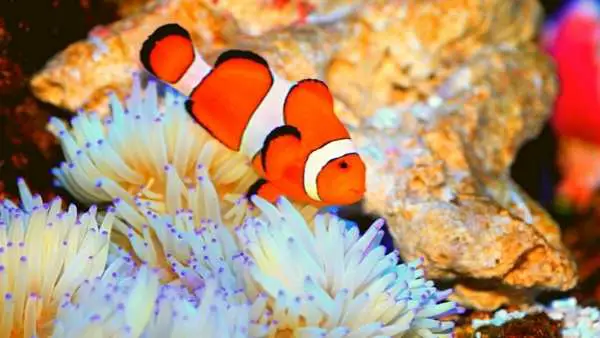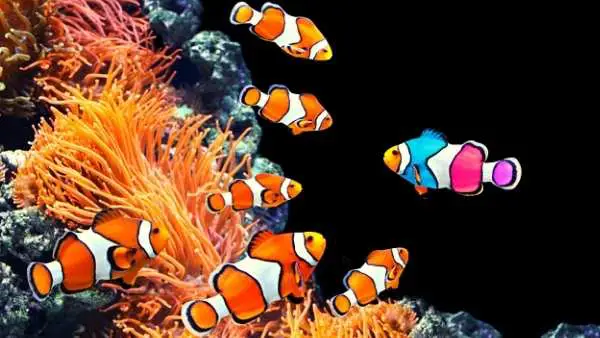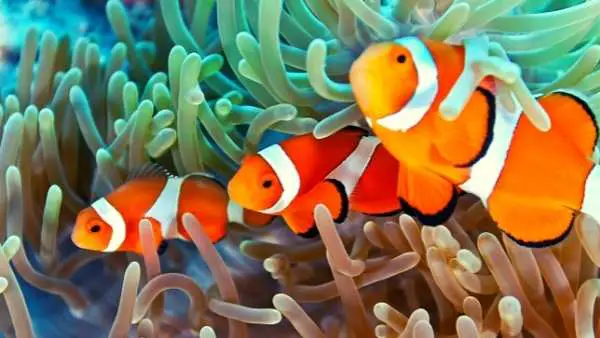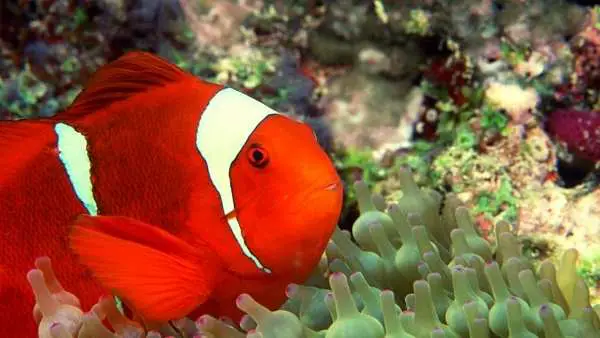Clownfish are perhaps one of, if not the most popular reef fish for hobbyists at any stage of their journey.
There are several valid reasons for this, and Clownfish received a huge amount of exposure and an increase in popularity due to the Nemo films. However, what primarily attracts people to these fish is their coloration, size, uniqueness, peaceful nature, and much, much more.
For many people, ranging from beginners to even expert aquarium owners and, more specifically, saltwater reef aquariums, a common occurrence is that people do not understand the different types of Clownfish. That is not surprising because there are are 30 species!

The most popular Clownfish are the True Percula Clownfish (Amphiprion Percula), and the Ocellaris Clownfish (Amphiprion Ocellaris), which also goes by the name of the "False Percula". These fish both share similar coloration, sporting bright orange bodies accompanied by black stripes, however, the similarities mostly end there, as there are many differences between the two species.
What is the difference between Ocellaris Clownfish and True Percula Clownfish?
The main difference between both species is their physical appearance, which may come as a surprise to many as they share the same colors and primary pattern. However, when you look closer, dig deeper, and fully analyze both fish species, you realize that there really is an abundance of differences between the two that is important to take note of.
In this article, we break down the differences between both clown fish species, and how to identify them both. The best way of doing this is by taking a close look at their color distribution, eye colors, dorsal fin spines, subtle size nuances, and more!
There are some misconceptions straight off the bat with these two species. Firstly, many people have assumed that the False Percula Clownfish is captive bred, which is why it has "False" in the name, although this isn't the reality, in fact, both species are wild caught.

Additional Information:
- Ocellaris Clownfish (False Percula Clown)
- This species is a wild-caught clown and tends to reside in the warm waters off the coast of Northern Australia and Southeast Asia.
- Their bodies consist of thin black lines, that outline and draw attention to the larger white stripes.
- They have black eyes with small droplets of orange.
- Their dorsal fins are comprised of 11 spines.
- True Percula Clown (True Percula Clownfish)
- They are usually found in the warm waters of New Guinea and the Solomon Islands.
- Their bodies are like their false counterparts, with thin black lines, that highlight the large white stripes.
- Their eyes are still black with a hint of orange, with the difference being how pronounced the orange is in their eyes.
- Instead of 11 spines, the True Percula has 10 spines that make the dorsal fin.
Due to the evident similarities between these two fish, it is understandable how people often get them confused with one another. Similar identity crises could be Leopards vs Jaguars or even Crocodiles vs Alligators. However, once you are aware and familiar with the differences, it is easy to identify who is who! Yes, the spines on the dorsal fins aren't exactly easy to distinguish, but the main difference between these two clown fish is the black lines, and more importantly, their thickness.
Which one of these Clownfish is Nemo?
One of the biggest reasons for the popularity of this fish is the Disney Pixar movie, "Finding Nemo", which involves an incredibly heartfelt story between a father clownfish and a son clownfish. Also, in the movie was Dory the Blue Tang.
So, which type of fish was Nemo himself? He was a False Percula (Ocellaris Clownfish). The easiest way of identifying this would be to look at the black lines that both clownfish possess.
Can both species of Clownfish live together?
This question is incredibly common and interesting too. So, the short answer is yes, they can! The two species are not only extremely similar visually, but they both possess remarkably similar characteristics too, they even host the same type of anemone.
They are so similar, in fact, that many people and hobbyists alike choose to mate the two species together to create their own "designer clownfish". They can make for great pairs and will be good tank mates, however, it is strongly advised to keep it to just one pair of clowns. The more clownfish added to your community the more chance of territorial aggression between them and simply buying an extra sea anemone or two won't do the trick. If you do have a large tank, with a plethora of fish within your community then you could look at possibly introducing more than two, but it is still not advised.

Do Clownfish need an anemone?
Despite popular belief, you do not need to have an anemone for your Clownfish. They are more than satisfied with live rock and open spaces to swim around in. Also, having small caves and similar hiding spots is advised too. However, the relationship between Clownfish and sea anemones has been common knowledge for several years, and the fish would certainly appreciate one as their home.
Also, in addition to pleasing your Clownfish, you are creating an awesome and somewhat unique display within your saltwater aquarium. Fortunately, both types of Clownfish - True Percula and False Percula host the exact same species of anemone, meaning that if you wanted to home both types of clowns and even potentially have them mate, they can share the same home.
Other than the two Clownfish mentioned here, there are plenty of other types of this incredible fish that have been commonly seen in aquariums and become popular hobbyist fish, here are some of them:
- Amphiprion Percula
- Cinnamon Clownfish
- Clarkii Clownfish
- Maroon Clownfish
- Pink Skunk Clownfish
- Tomato Clownfish
There are so many Clownfish living in a multitude of different areas of the world, and it is important to understand and possess the knowledge of how to look after them properly. An example of this would be the Cinnamon Clownfish that do not socialize well with other Clownfish, so keeping them away from other types is a must.
As well as this, the two Clownfish that are the focus of this article, have certain similarities in their requirements, needs, care, tank, water, and more, but this does not mean that the True Percula Clownfish and the Ocellaris Clownfish have the exact same requirements as, foe example, the Pink Skunk Clownfish. The Amphiprion perideraion are more delicate that most other clownfish and reliant on a host anemone.
How long do Clownfish live for?
The answer to this question is far from straightforward, it really depends on the type of fish. For the True Percula, you can expect your fish to live up to around 20 years, although some females have been known to live much longer.
The False Percula however, has a much shorter life expectancy, living to around 6 years. These estimates are just an average though, and your Clownfish can and most likely will live for longer or shorter depending on the type of care and environment it is given.
How many Clownfish should I keep together?

If you own a small to medium-sized aquarium, it is not a great idea to introduce more than two. The Clownfish can be known to be aggressive and territorial, especially with other Clownfish tank mates, which can end up disturbing and disrupting the community.
Just because keeping in pairs is advised, doesn't mean they have to be from the same species. The True Clownfish and the False Clownfish will live in harmony together as long as they are a pair. Although, if you are not getting these two specific species, then it makes sense to look their compatibility up before taking the plunge, just in case!
Many people are curious as to whether clownfish are good for beginners. Clownfish are one of the best fish to buy for novice hobbyists for many brilliant reasons. Due to them being omnivores they have flexibility within their diet, so feeding the True Percula Clownfish or Ocellaris Clownfish is great, they take Brine Shrimp, and frozen fish too, but any other meaty options they will happily accept. Pallet vegetables are hugely important to introduce to their diet too.
Oddly enough, if you want your fish to make an anemone their new home, it is strongly advised to introduce the anemone first before adding the fish. That way the anemone is established within your tank and community, and your Clownfish hasn't found an equally exciting home somewhere else in the tank before you introduce the anemone.
Clownfish Tank Setup
Clownfish tank setup is one of the most important things with any happy, successful, and peaceful community! There are some subtle differences between the different clowns when it comes to their tanks.
The Amphiprion Ocellaris won't need much space to have a prosperous and happy life, so, a smaller tank will suit them just fine. Beware that waste and dirt build up a lot quicker in smaller reef aquariums due to there being less water. For beginners, even though your clownfish won't need much space, it is still advised to go with a larger tank as it simply won't require as much maintenance and work that you must stay on top of.
Here are the water parameters for both types of Clownfish:
- The temperature should be between 73 to 80 degrees Fahrenheit (22 to 26 degrees Celsius), heater required.
- The pH level should be between 8 and 8.4.
- Specific gravity between 1.021 and 1.026.
- Moderate water movement is required.
If you are planning on keeping your Clownfish with anemone then you will need intense lighting, however, if you are just keeping the Clownfish on this list without an anemone to accompany it, you can go with moderate lighting – it is the anemone that requires the intense lighting.

Summary
In conclusion, both the Amphiprion Percula and Ocellaris Clownfish are two of the most identifiable fish you could add to any community, as well as possessing some of the most beautiful coloration and patterns. They are also peaceful and friendly by nature if you look after them correctly and follow the advice provided. They are brilliant for beginners and experts alike and are truly worth investing in for your aquarium.

